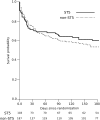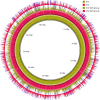Comparative genomics of Cryptococcus neoformans var. grubii associated with meningitis in HIV infected and uninfected patients in Vietnam
- PMID: 28614360
- PMCID: PMC5484541
- DOI: 10.1371/journal.pntd.0005628
Comparative genomics of Cryptococcus neoformans var. grubii associated with meningitis in HIV infected and uninfected patients in Vietnam
Abstract
The vast burden of cryptococcal meningitis occurs in immunosuppressed patients, driven by HIV, and is caused by Cryptococcus neoformans var. grubii. We previously reported cryptococcal meningitis in Vietnam arising atypically in HIV uninfected, apparently immunocompetent patients, caused by a single amplified fragment length polymorphism (AFLP) cluster of C. neoformans var. grubii (VNIγ). This variant was less common in HIV infected individuals; it remains unclear why this lineage is associated with apparently immunocompetent patients. To study this host tropism we aimed to further our understanding of clinical phenotype and genomic variation within Vietnamese C. neoformans var. grubii. After performing MLST on C. neoformans clinical isolates we identified 14 sequence types (STs); ST5 correlated with the VNIγ cluster. We next compared clinical phenotype by lineage and found HIV infected patients with cryptococcal meningitis caused by ST5 organisms were significantly more likely to have lymphadenopathy (11% vs. 4%, p = 0.05 Fisher's exact test) and higher blood lymphocyte count (median 0.76 versus 0.55 X109 cells/L, p = 0.001, Kruskal-Wallis test). Furthermore, survivors of ST5 infections had evidence of worse disability outcomes at 70 days (72.7% (40/55) in ST5 infections versus 57.1% (52/91) non-ST5 infections (OR 2.11, 95%CI 1.01 to 4.41), p = 0.046). To further investigate the relationship between strain and disease phenotype we performed genome sequencing on eight Vietnamese C. neoformans var. grubii. Eight genome assemblies exhibited >99% nucleotide sequence identity and we identified 165 kbp of lineage specific to Vietnamese isolates. ST5 genomes harbored several strain specific regions, incorporating 19 annotated coding sequences and eight hypothetical proteins. These regions included a phenolic acid decarboxylase, a DEAD-box ATP-dependent RNA helicase 26, oxoprolinases, a taurine catabolism dioxygenase, a zinc finger protein, membrane transport proteins and various drug transporters. Our work outlines the complexity of genomic pathogenicity in cryptococcal infections and identifies a number of gene candidates that may aid the disaggregation of the pathways associated with the pathogenesis of Cryptococcus neoformans var. grubii.
Conflict of interest statement
The authors have declared that no competing interests exist.
Figures




Similar articles
-
Most cases of cryptococcal meningitis in HIV-uninfected patients in Vietnam are due to a distinct amplified fragment length polymorphism-defined cluster of Cryptococcus neoformans var. grubii VN1.J Clin Microbiol. 2011 Feb;49(2):658-64. doi: 10.1128/JCM.01985-10. Epub 2010 Dec 15. J Clin Microbiol. 2011. PMID: 21159929 Free PMC article.
-
A prospective descriptive study of cryptococcal meningitis in HIV uninfected patients in Vietnam - high prevalence of Cryptococcus neoformans var grubii in the absence of underlying disease.BMC Infect Dis. 2010 Jul 9;10:199. doi: 10.1186/1471-2334-10-199. BMC Infect Dis. 2010. PMID: 20618932 Free PMC article.
-
Assessing the virulence of Cryptococcus neoformans causing meningitis in HIV infected and uninfected patients in Vietnam.Med Mycol. 2020 Nov 10;58(8):1149-1161. doi: 10.1093/mmy/myaa013. Med Mycol. 2020. PMID: 32196550 Free PMC article.
-
Cryptococcus neoformans var. grubii Infection in HIV-Seronegative Patients from Northeast India: Report of Two Cases with Review of Literature.Mycopathologia. 2016 Apr;181(3-4):315-21. doi: 10.1007/s11046-015-9971-5. Epub 2015 Dec 16. Mycopathologia. 2016. PMID: 26677012 Review.
-
Epidemiology of Cryptococcus and cryptococcosis in China.Fungal Genet Biol. 2015 May;78:7-15. doi: 10.1016/j.fgb.2014.10.017. Epub 2014 Nov 7. Fungal Genet Biol. 2015. PMID: 25445309 Review.
Cited by
-
Analyses of the Global Multilocus Genotypes of the Human Pathogenic Yeast Cryptococcus neoformans Species Complex.Genes (Basel). 2022 Nov 6;13(11):2045. doi: 10.3390/genes13112045. Genes (Basel). 2022. PMID: 36360282 Free PMC article.
-
Cryptococcus neoformans Causing Meningoencephalitis in Adults and a Child from Lima, Peru: Genotypic Diversity and Antifungal Susceptibility.J Fungi (Basel). 2022 Dec 16;8(12):1306. doi: 10.3390/jof8121306. J Fungi (Basel). 2022. PMID: 36547639 Free PMC article.
-
Molecular Markers Reveal Epidemiological Patterns and Evolutionary Histories of the Human Pathogenic Cryptococcus.Front Cell Infect Microbiol. 2021 May 6;11:683670. doi: 10.3389/fcimb.2021.683670. eCollection 2021. Front Cell Infect Microbiol. 2021. PMID: 34026667 Free PMC article. Review.
-
Cryptococcal Virulence in Humans: Learning From Translational Studies With Clinical Isolates.Front Cell Infect Microbiol. 2021 Apr 21;11:657502. doi: 10.3389/fcimb.2021.657502. eCollection 2021. Front Cell Infect Microbiol. 2021. PMID: 33968804 Free PMC article. Review.
-
Virulence-associated variants in Cryptococcus neoformans sequence type 93 are less likely to be associated with population structure compared to independent rare mutations.Microbiol Spectr. 2025 Jan 7;13(1):e0170924. doi: 10.1128/spectrum.01709-24. Epub 2024 Nov 27. Microbiol Spectr. 2025. PMID: 39601574 Free PMC article.
References
-
- Park BJ, Wannemuehler KA, Marston BJ, Govender N, Pappas PG, Chiller TM. Estimation of the current global burden of cryptococcal meningitis among persons living with HIV/AIDS. Aids. 2009;23(4):525–30. doi: 10.1097/QAD.0b013e328322ffac - DOI - PubMed
-
- Casadevall A, Perfect JR. Cryptococcus neoformans. 1 ed Washington: American Society for Microbiology Press; 1998. 1998. 541 p.
-
- Chen S, Sorrell T, Nimmo G, Speed B, Currie B, Ellis D, et al. Epidemiology and host- and variety-dependent characteristics of infection due to Cryptococcus neoformans in Australia and New Zealand. Australasian Cryptococcal Study Group. ClinInfectDis. 2000;31(2):499–508. - PubMed
-
- Dromer F, Mathoulin S, Dupont B, Laporte A. Epidemiology of cryptococcosis in France: a 9-year survey (1985–1993). French Cryptococcosis Study Group. ClinInfectDis. 1996;23(1):82–90. - PubMed
-
- Chau TT, Mai NH, Phu NH, Nghia HD, Chuong LV, Sinh DX, et al. A prospective descriptive study of cryptococcal meningitis in HIV uninfected patients in Vietnam—high prevalence of Cryptococcus neoformans var grubii in the absence of underlying disease. BMC Infect Dis. 2010;10:199 doi: 10.1186/1471-2334-10-199 - DOI - PMC - PubMed
Publication types
MeSH terms
Grants and funding
LinkOut - more resources
Full Text Sources
Other Literature Sources
Medical

